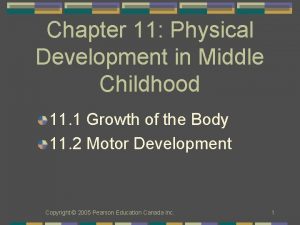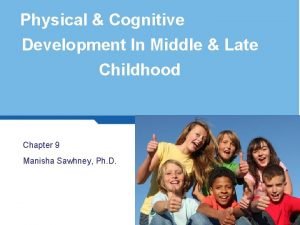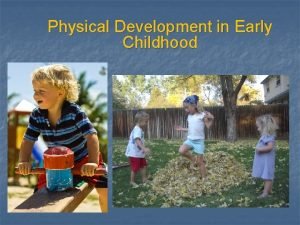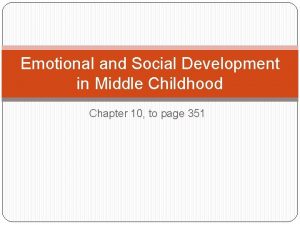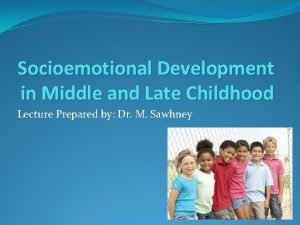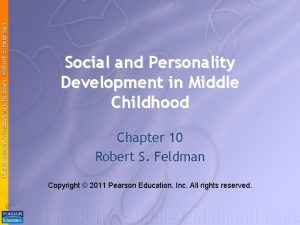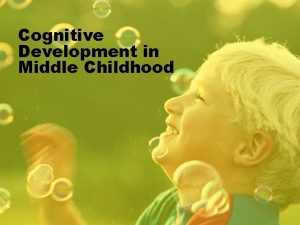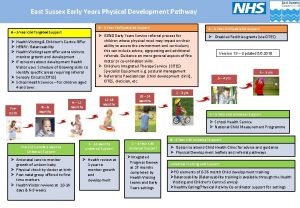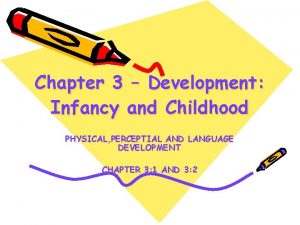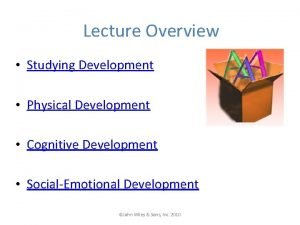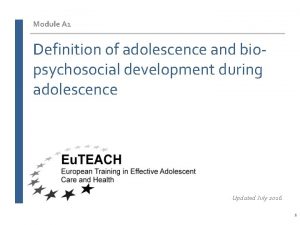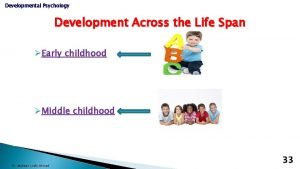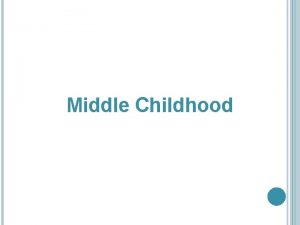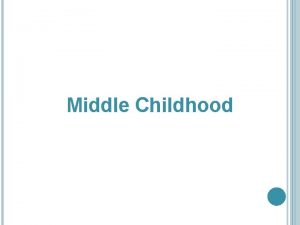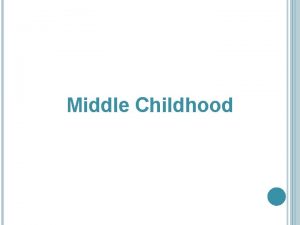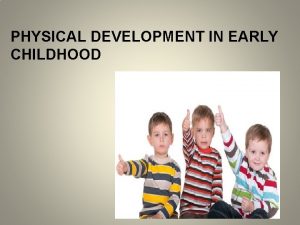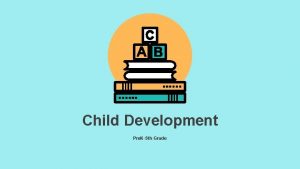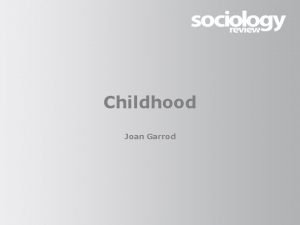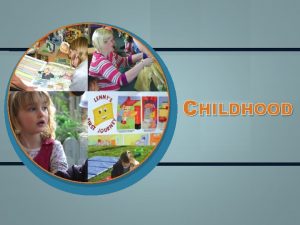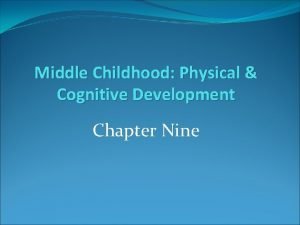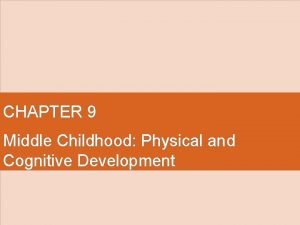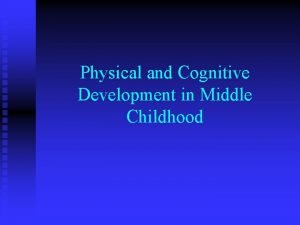Physical Development in Middle Childhood 6 11 yearolds


















- Slides: 18

Physical Development in Middle Childhood 6 -11 year-olds Chapter 10

Today we will talk about • Physical growth • Brain development • Nutrition & Obesity • Exercise • Health Issues • Special Education • Autism

Physical Growth • Slow and steady growth rate • Gain 5 -7 lbs. per year • Grow 2 inches a year • Slim down & gain muscle strength • Bones grow and muscles strengthen= engaging in strenuous physical activity • Mastering of gross & fine motor skills

Brain Development • Brain reaches its adult size around age 7 Frontal lobe becomes more developed( 10 -12 yrs. ) • Control panel of the brain • emotional expression, problem solving, memory, language, judgment, and sexual behaviors • Logic, planning, memory improves Plan & coordinate activity using left & right hemispheres of the brain • Control development of emotions, physical abilities, intellectual abilities

Brain Development Prefrontal cortex matures • Attention span improves Myelination continues • Improvement in reaction time • Information processing speed increases • Improvements in memory ( myelination in the hippocampus)

Nutritional Needs • What has influenced your eating habits? • How has television influenced what children eat? • What are some of the unhealthy types of foods that you have eaten as a child? • Need more macronutrients (carbohydrates, fats, proteins) & micronutrients(vitamins/minerals) than adults • Food insecurity: the state of being without reliable access to a sufficient quantity of affordable, nutritious food. • In the United States, about 20% of households w/ children are food insecure to some degree. • Deficiencies in: iron, zinc, protein, vitamin A= stunted growth, illness, limited development • National School Lunch Program provides low- income families w/ breakfast, lunch, snacks • How has COVID impacted children’s ability to get access to food? • My Plate Website

Small Group Discussions pg. 260 - 262 • In your break- out rooms discuss the following: 1. What is causing childhood obesity? List all the causes you can think of. 2. What are the social implications of children who are overweight/obese? 3. How can parents help overweight/obese children reach a healthy weight? • Be prepared to participate in the main room

Childhood Obesity • Impacts children Physical, cognitive and social and emotional domains of development! • Physical issues related to obesity: high blood insulin resistance, inflammation, depression, lower academic achievement, childhood diabetes, knee injuries, high risk of • Brain functioning issues related to obesity: - deficits in executive functioning (planning, self-monitoring, self-control, working memory, time management, and organization) - mental flexibility (switching in thinking between two different concepts) - decision making, difficulty in impulse control and delayed gratification

Childhood Obesity • Body Mass Index (BMI): measurement for determining excess weight by looking at height &weight. • BMI is at or above the 85 th percentile for age = overweight, • BMI is at or above the 95 th percentile for age are= obese • About 16% to 33% of American children are obese • CDC BMI Calculator Tool


Exercise, Physical Fitness, and Sports • What physical activities did you participate in as a child? • Recess & Physical Education (PE) • teaches skills, rules, and games • Play time for children has been cut back due to testing • only Oregon and the District of Columbia meet PE guidelines • Guideline is providing a minimum of 150 minutes per week of physical activity • Did you participate in organized sports?

positive aspects of organized sports negative aspects of organized sports • Children’s participation in sports has been linked to: higher levels of satisfaction with family and overall quality of life in children Improved physical and emotional development Better academic performance • Emphasis on competition and athletic skill • parent pressure • adults become involved and approach the games as adults rather than children. • Not affordable/accessible to all children (children with disabilities) • Caucasian girls/ boys participated in organized sports at higher rates than minority children • fathers may not be providing their daughters as much support as they do their sons.

Physical Health • Myopia (nearsightedness): inability to see distant objects clearly while close objects are clear. • common vision problem in middle childhood • 25% of children will be diagnosed by the end of middle childhood • Loss of baby teeth and the arrival of permanent teeth (starts from age 6 -7) • Children need to brush and floss daily 2 x a day

Physical Health • Asthma: chronic lung disease that inflames and narrows the airways • causes recurring periods of wheezing (a whistling sound when you breathe), chest tightness, shortness of breath, and coughing • About 7 million children have asthma

Mental Health • mental health problems can lead to: school failure, alcohol or other drug abuse, family discord, violence or even suicide • A qualified professional will make a diagnosis • A diagnosis well help a child get the right help they need • Some children are labeled for their disability • Labeling can impact a child’s self-concept in a negative way

Special Education • About 13% of children in U. S. public schools are receiving services under a federal law • Before 1960 children with special needs did not attend school • IDEA= Individuals w/Disabilities Education Act • Students get an IEP=Individualized Education Plan • Educated with nondisabled peers to the greatest extent possible • LRE=Least restrictive environment • Some schools may use inclusion • Let’s Watch

Autism Spectrum Disorder (ASD) • • - Developmental disorder Symptoms appear w/in 2 years of life Variation in the type and severity of the symptoms people experience Social Communication Little or inconsistent eye contact Not looking or listening to people Difficulty w/back & forth conversations • - Repetitive Behaviors words/phrases is called echolalia Lasting intense interest in topics: #, facts, details Upset at changes in routine More/less sensitive in sensory input: lights, noise, clothing, temperature -flapping arms/ banging head

Autism Spectrum Disorder (ASD) • Don’t know the exact cause • Risk factors include: - Having a sibling w/ ASD - Older parents - Very low birth weight - Having certain genetic conditions • Treatments - Medication to reduce irritability, aggression, hyperactivity, attention problems - Applied Behavioral Therapy: setting goals for child and rewarding desired behaviors and ignoring undesired behaviors - Regional Center
 Physical development in middle childhood
Physical development in middle childhood Physical development in middle childhood chapter 11
Physical development in middle childhood chapter 11 Middle and late childhood physical development
Middle and late childhood physical development Physical development in middle childhood
Physical development in middle childhood Early middle childhood
Early middle childhood Middle and late childhood
Middle and late childhood Emotional development in middle childhood
Emotional development in middle childhood Middle and late childhood development
Middle and late childhood development Damon's stages of friendship
Damon's stages of friendship Middle childhood growth and development
Middle childhood growth and development Language development in middle childhood
Language development in middle childhood Physical development in early childhood
Physical development in early childhood Infancy and childhood physical development
Infancy and childhood physical development Development
Development Rovee-collier
Rovee-collier Late adolescence
Late adolescence Filial maturity
Filial maturity Middle adulthood physical changes
Middle adulthood physical changes Characteristics of social development
Characteristics of social development

